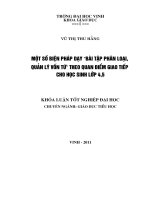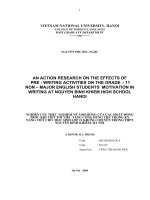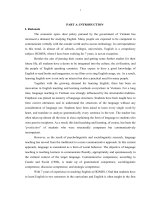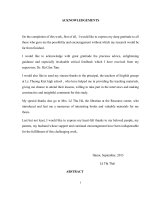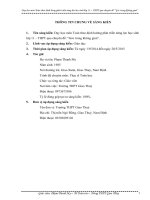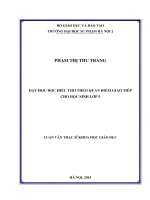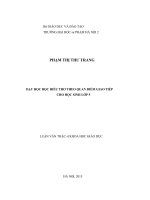DẠY NGỮ PHÁP TIẾNG ANH THEO ĐỊNH HƯỚNG GIAO TIẾP CHO HỌC SINH LỚP 11, BAN D, TRƯỜNG THPT YÊN HÒA, HÀ NỘI
Bạn đang xem bản rút gọn của tài liệu. Xem và tải ngay bản đầy đủ của tài liệu tại đây (369.01 KB, 69 trang )
VIETNAM NATIONAL UNIVERSITY
UNIVERSITY OF LANGUAGES AND INTERNATIONAL STUDIES
FACULTY OF ENGLISH LANGUAGE TEACHER EDUCATION
GRADUATION PAPER
TEACHING ENGLISH GRAMMAR IN THE LIGHT
OF COMMUNICATIVE APPROACH TO 11TH
GRADERS IN BLOCK D
AT YEN HOA HIGH SCHOOL, HANOI
Supervisor: Trần Thị Hiếu Thủy (MA)
Student: Kim Thúy An
Year: QH2010
HANOI – 2014
ĐẠI HỌC QUỐC GIA HÀ NỘI
TRƯỜNG ĐẠI HỌC NGOẠI NGỮ
KHOA SƯ PHẠM TIẾNG ANH
KHOÁ LUẬN TỐT NGHIỆP
DẠY NGỮ PHÁP TIẾNG ANH THEO ĐỊNH HƯỚNG
GIAO TIẾP CHO HỌC SINH LỚP 11, BAN D,
TRƯỜNG THPT YÊN HÒA, HÀ NỘI
Giáo viên hướng dẫn: Trần Thị Hiếu Thủy
Sinh viên: Kim Thúy An
Khoá: QH2010
HÀ NỘI – NĂM 2014
2
ACCEPTANCE PAGE
I hereby state that I: Kim Thúy An, class QH2010.F.1.E1, being a candidate
for the degree of Bachelor of Arts (TEFL) accept the requirements of the College
relating to the retention and use of Bachelor’s Graduation Paper deposited in the
library.
In terms of these conditions, I agree that the origin of my paper deposited in
the library should be accessible for the purposes of study and research, in
accordance with the normal conditions established by the librarian for the care, loan
or reproduction of the paper.
Signature
Date
May 4, 2014
ACKNOWLEDGEMENTS
First and foremost, I would like to express my deepest and most sincere
gratitude to my supervisor, Ms. Trần Thị Hiếu Thủy, for her continuous support and
encouragement. Especially, without her precious consultation, careful guidance and
feedback, this graduation paper would not be completed.
With no less sincerity, my thanks should go to my senior, Mr. Trần Quốc
Trung, who is currently a lecturer of Faculty of English Language Teacher
Education for his support and guidance.
Moreover, I owe 91 students and 2 teachers from Yen Hoa High School,
Hanoi that agreed to take part in this research. Their active and responsible
participation overtime has been a great encouragement for me to continue my work.
Last but not least, all my heart is dedicated to my parents, my lover, Nguyễn
Tuấn Hải, and my best friend, Nguyễn Hà My, who have been providing me every
piece of care and support to complete this study.
4
ABSTRACT
Grammar plays an important role in teaching and learning English language.
However, how to teach grammar effectively is not easy, and it is of constant
concern of most high school teachers. In the context of grade 11, Yen Hoa High
School, Hanoi, there have been virtually no studies about teaching grammar,
especially in the light of Communicative Approach. Therefore, the current study
was carried out to contribute to this area of research. The participants of the study
were 91 students of class 11D3 and 11D5 as well as their two English teachers at
Yen Hoa High School. Data was collected in three methods: classroom observation,
teacher interview and questionnaires. Both qualitative and quantitative analysis
strategies were employed to investigate the collected data. The results of the study
suggest that the teachers in Yen Hoa High School are trying to apply
Communicative Approach in grammar teaching, yet due to several major factors
they sometimes could not follow the theory strictly. As a result, the Practice stage is
mostly mechanical and the Production stage was omitted. Additionally, the study
reveals several difficulties encountered by the teachers in which the most
prominent difficulties were (1) time management, (2) heavy workload, (3) lack of
creativity and (4) the requirement of current education and examination system in
Vietnamese context. Besides, the research presents some recommendations and
suggestions from both teachers and students, for instance, the syllabus should be
redesigned to agree with the teaching method and examination system should be
changed into more communicative, rather than paper-based.
5
TABLE OF CONTENTS
LIST OF ABBREVIATION
A: Answer
Block A: Specializing in three subjects: Mathematics, Physics and
Chemistry
Block D: Specializing in three subjects: Mathematics, Literature and
English.
Block Science: Specializing in Science subjects: Mathematics, Physics,
Chemistry and Biology
CLT: Communicative Language Teaching
EFL: English as a Foreign Language
ESL: English as the Second Language
PPP: Presentation – Practice – Production
Q: Question
6
Ss: Students
T: Teacher
TBT: Task-based - Teaching
TTT: Test – Teach – Test
YHS: Yen Hoa High School, Hanoi
LIST OF TABLES AND FIGURES
No. Name Page
Graphs
1 Graph 1: The normal procedure of a grammar lesson 21
2
Graph 2: The aspects teacher normally address when
presenting a new grammar structure
24
3
Graph 3: The activity students mainly do in a grammar
lesson
25
4
Graph 4: The method teacher normally uses to present a
new grammar structure
28
5
Graph 5: Students’ assessment of the interest of grammar
lessons
29
6
Graph 6: Students’ assessment of the effectiveness of
grammar lessons
30
Tables
7
Table 1: The activity students have taken part in the
Practice stage
25
8 Table 2: The activity students have taken part in the 27
7
Production stage
8
PART 1: INTRODUCTION
This chapter justifies the statement of the research problems, the rationale
and significance of the research. Also in this chapter, the aim and scope of the study
and research questions are presented. A brief introduction to proposed structure is
also included.
1. Statement of research problem and rationale for the study
It has widely been accepted that grammar structures are tremendously
important since they construct the framework of a language. (Lin, 2008) Students,
with good grammar competence, not only produce sentences grammatically but
also have the ability to express their ideas, thoughts and feelings in certain contexts.
By teaching grammar, teachers not only provide students with the means to express
themselves, but also fulfill students’ expectations of what learning a foreign
language involves.
However, how to teach grammar effectively is not easy, and it is of constant
concern of high school teachers. In the past, English learning and teaching at
Vietnamese school mostly concentrated on grammatical structures and rules. Yet,
recently, there have been certain improvements in English language teaching in the
light of Communicative Approach which is adaptable to required objectives and
help students get more opportunities to communicate in English. However, at many
high schools in Vietnam, teaching English grammar still has not been successful in
developing students’ communication ability, activeness and motivation. (Tran,
2013)
So far, a number of studies have been conducted to assist teachers in
teaching English grammar communicatively in the Vietnamese context. These
include “A Study on teaching English Grammar Structures communicatively to 10
th
Form students in Hanoi” (Vu, 2004) , “Techniques to Present New Grammar
Communicatively to Grade 10 Students in Hanoi” (Pham, 2008), “Teachers’
Difficulties in Teaching Grammar Communicatively for Ethnic Minority Students at
Hagiang Medical Secondary School” (Vuong, 2008) and “Using Communicative
Activities to Support Grammar Teaching for Large Multilevel Cases at Electric
9
Power University” (Trinh, 2010), to name but a few. However, not many of them
have been made in the scope of grade 11 at high schools in Hanoi. The two rare
studies on this subject (Vu, 1998) was conducted 16 years ago, and therefore, may
not provide up-to-date information to other educators and researchers who share the
same interest. This situation has offered the researcher a chance to conduct a study
on: “Teaching English Grammar in the Light of Communicative Approach to 11
th
Graders in Block D at Yen Hoa High School, Hanoi.”
2. Aims and objectives of the study
Primarily, by taking a closer look at the issue, this research paper expected
to investigate the current situation of teaching English grammar (hereafter
mentioned as grammar) to 11
th
-grade students in block D at YHS (hereafter
addressed as students). Moreover, the researcher also aimed at finding out the
difficulties faced by the teachers when teaching grammar communicatively to the
11
th
graders in block D. Basing on the results of the study, the researcher proposed
several recommendations in the hope of enhancing the effectiveness of grammar
lessons at YHS. In brief, this paper addressed the following research questions:
Question 1: From the perceptions of teachers’ and 11
th
-grade students’ in Block
D at YHS, is the current method of their teaching and learning English grammar
communicative?
Question 2: What are the difficulties when teaching grammar communicatively
to 11
th
-grade students in block D at YHS, as perceived by teachers?
Question 3: What are possible recommendations to enhance the effectiveness of
teaching grammar communicatively at YHS, as perceived by teachers and
students?
3. Significance of the study
10
Once completed, the researcher hopes that the study would bring certain plus
points to teachers and students at YHS, which could be a considerable contribution
to teaching and English grammar effectively and enjoyably at YHS.
Specifically, to the teacher’s side, the finding of the research may allow
them to have a closer look at the current situation of teaching grammar to block-D
students in grade 11 as well as their students’ opinions and attitude toward grammar
lessons. Moreover, they were offered an opportunity to reveal their difficulties in
teaching grammar. Hence, they can make some adjustment to their teaching
methods in order to help their students develop English grammar ability as well as
interest in grammar lessons.
To the students, through the study, they were able to express their thoughts,
feelings and attitudes during grammar classes, to what extent the effectiveness of
current method was, what they wanted to change or adjust. Especially, the study
would expand their opportunity to study English grammar in a more interactive
environment instead of passive and unmotivated one.
Along with that, as for other researchers who share the same interest in this
topic, they can refer to this paper as a source of updated and credited information.
4. Scope of the study
Due to resource constraints, the study could not cover all aspects of teaching
English grammar. It only focused on communicative teaching techniques to help
students achieve fluency in grammar competence.
Regarding the population of the research, because of time limit and
convenience, the researcher concentrated on the teaching of grammar to 11
th
graders in block D. The researcher had the six-week-internship time to work with
11
th
graders in block D at Yen Hoa High School, Hanoi, therefore, collecting data
from this population was the most convenient and time-saving to the researcher.
Investigation into any of the following issues:
• other methods of teaching grammar
• other high schools
• other blocks (such as block A or Science)
• other grades (such as grade 10 or 12)
11
would go beyond this scope.
5. Organization of the study
This research consisted of 3 parts, appendices and a list of references.
Part 1: Introduction
This part stated the research problems, the significance and scope of the study
and proposes questions to answer.
Part 2: The study: This part consisted of 3 chapters
Chapter 1: Literature review
This chapter included the explanation of key concepts as well as the review on
different previous studies.
Chapter 2: Methodology
This chapter comprised of research participants, population and sampling
method; data collection and data analysis methods and procedure.
Chapter 3: Findings & Discussion
In this chapter, research findings were presented with further thorough and
thoughtful discussion.
Part 3: Conclusion
This part provided a summary for all the main issues mentioned in the research,
limitation of the research, pedagogical implications and suggestions for further
studies.
List of references
The list was of works consulted to conduct this research.
Appendices
This part showed the teacher interview questions and transcripts, the
observation checklist that was used in this research and the questionnaires that were
sent to participants to ask for their information in this study.
12
PART 2: THE STUDY
CHAPTER 1: LITERATURE REVIEW
This chapter explains the key concepts, as well as provides a review on the
works relevant to the topic. A gap for the research would also be indicated, creating
the path for this study to be implemented.
1. Key concepts
1.1. Traditional Second Language Teaching Methods
1.1.1. The Grammar Translation method: Advantages & Disadvantages
The grammar-translation method was a dominant method in foreign
language teaching during the late nineteenth century to the twentieth (To et al.,
2011). In its modified form, it has continued to be used in some places nowadays.
Grammar-Translation is a way of studying a language that approaches the
language first through detailed analysis of its grammar rules, followed by the
application of this knowledge to the task of translating sentences and texts
into and out of the target language. Hence, it views language learning as
consisting of little more than memorizing rules and facts in order to
understand and manipulate the morphology and syntax of the foreign
language” (Richard & Rogers, 1996, p.52).
According to Prator & Celce – Murcia (1979), the teaching of grammar
possesses the following features:
(1) Classes are taught in the mother tongue, with little active use of the target
language.
(2) Much vocabulary is taught in the form of lists of isolated words.
(3) Long elaborate explanations of the intricacies of grammar are given.
(4) Grammar provides the rules for putting words together, and instruction
often focuses on form and inflection of words.
(5) Reading of difficult classical texts is begun early.
(6) Little attention is paid to the content of texts, which are treated as
exercises in grammatical analysis.
(7) Often the only drills are exercises in translating disconnected sentences
from the target language into the mother tongue.
(8) Little or no attention is given to pronunciation. (To et al., 2011, p.18)
Advantages
There are some strong points of this method that can be drawn from its
above features. Primarily, the grammar-translation method focuses on grammatical
parsing, for instance, the form and inflection of words so that good knowledge of
13
grammar helps the learners do very well in writing and reading. Especially,
emphasis is on accuracy. Furthermore, grammar translation appears very easy to
apply, particularly even in large classes when the learners learn a single word in the
dictionary and they have to memorize vocabulary which is given in the list of
words. This method does not require much creativity and effort of the teacher as
well as an ability to speak the target language. Teacher can use grammatical
explanations and exercises written in the textbooks or grammatical books in mother
tongue. Besides, translation is often a quick and effective way of teaching difficult
and abstract words. It can reject the ambiguity or misunderstanding between
students in learning a new grammatical structure as everything is translated clearly
into their mother tongue. Similarly, a short explanation is often better than a long
one in the targeted language, especially for beginners. (Teaching English as a
Foreign Language: Grammar Translation Method, 2013)
Disadvantages
However, this method has some shortcomings and has been strongly
criticized because “it is based on language study (grammar, literature) and written
exercises (translation) rather than real life communication and speech” (To et al.,
2011, p.19). Students are considered to be passive recipients of the given
knowledge. They learn by absorbing the teacher’s explanation in the mother
tongue, memorizing grammar rules and vocabulary list. To be clearer, the grammar-
translation method emphasizes too much on the language as a mass of rules,
therefore, learners have little time to practice. They do not have many chances to
think, learn and conduct meaningful communicative activities in the target
languages. (Teaching English as a Foreign Language: Grammar Translation
Method, 2013). Because of its weak points and inefficient outcome, this method is
rarely used in learning and teaching foreign language in schools in the world
nowadays. Even in Vietnam, although grammar translation method used to be
popular for a long time, the use of this method in schools has proved many
drawbacks and hence needs to be changed.
14
1.1.2. The Audio Lingual method: Advantages & Disadvantages
This approach became dominant in the United States during World War II
and then was applied to the teaching of ESL in many other places.
Here is a summary of the key features of the Audio Lingual method, taken
from Brown (1994) and adapted from Prator and Celce-Murcia (1979),
Harmer (2002), Richards & Rodgers (1996).
1. The primary objective is oral proficiency. Writing is avoided in the early
stages.
2. New material is presented in dialog form.
3. There is dependence on mimicry, memorization of set phrases, and
overlearning.
4. Structures are sequenced by means of contrastive analysis and taught once
at a time.
5. Structural patterns are taught using repetitive drills.
6. There is little or no grammatical explanation. Grammar is taught by
inductive analogy (examples and drills) rather than deductive explanation.
7. Vocabulary is strictly limited and learned in context.
8. There is much use of tapes, language labs, and visual aids.
9. Great importance is attached to pronunciation from beginning.
10. Very little use of the mother tongue by teachers is permitted.
11. Successful responses are immediately reinforced.
12. The presentation of new language items is tightly graded in order to
minimize possibility for making mistakes.
13. There is great effort to get students to produce error-free utterances.
14. There is a tendency that language us often manipulated without regard to
meaning and context. (To et al., 2011, p.22)
Advantages:
Vu (2004) offered some plus points of Audio-Lingual method as follow:
• The primary objective is oral proficiency. Writing is avoided in the early
stage.
• The focus is on phonological and grammatical structures rather than
vocabulary, i.se, teach many structures with a limited amount of
vocabulary (beginners and intermediate students)
• Analogy (examples and drills) is better than analysis (grammar rules)
• Grammar is taught inductively, rather than deductively
• Teach the language, not about the language
• Pronunciation is stressed from the beginning
15
• The presentation of new language items is tightly graded in order to
minimize possibilities for making mistakes.
• Dialogues and drills (pattern practice) form the basis of audio lingual
classroom practices
• Audiovisual aids (e.g. tape recorders, slides, pictures, language lab, etc.)
assist teacher and learners. (Vu, 2004)
Disadvantages:
Nevertheless, this method also proves some weak points. Firstly, students’
vocabulary is simple and limited because most of the words are learned in a
dialogue context and learning activities and materials are carefully controlled.
Secondly, students are turned into a kind of machine through repetitive drills,
mimicry and memorization of set phrases, which cannot be flexible and do not help
to promote their creativity. In the long run it will make them to be in boredom.
(Romero, 2013)
1.2. Communicative Language Teaching (CLT)
1.2.1. Definitions
Richards & Rodgers (1996) defined that Communicative Approach is in
which the goal of language teaching is communicative competence and it aims at
developing procedure for the teaching of the four language skills that acknowledge
the interdependence of language and communicative. They believed that it is best
considered an approach rather than a method.
Vu (2004) in her own research also stated that Communicative Approach is a
development of the work of anthropological linguists who view language primarily
as a system for communication. Communicative Approach is then developed as the
state-of-the-art method of teaching foreign language under the name
“communicative language teaching.”
CLT represents language teaching philosophies that can be interpreted and
applied in various distinctive ways in the classroom. (Rodgers, 2001, cited in
Pham, 2008, p.7)
16
1.2.2. Objectives
According to To et al. (2011), the objective of CLT is to produce
communicatively competent students. Communicative competence per se consists
of five dimensions which are discourse competence, linguistic competence, actional
competence, sociocultural competence and strategic competence. Discourse
competence is considered the core. (Celce-Murcia et al., 1995, cited in To et al.,
2011)
Piepho (1981, cited in Richards & Rodgers, 1996, p.73) offered five levels
of objectives in a Communicative Approach:
1. An integrative and content level (language as a means of expression)
2. Linguistic and instrumental (language as a semiotic system and an object
of learning)
3. An affective level of interpersonal relationships and conduct (language as
a means of expressive values and judgments about oneself and others)
4. A level of individual learning needs (remedial learning based on error
analysis)
5. A general educational level of extra-linguistic goals (language learning
within the school)
1.3. Grammar competence in CLT
1.3.1. Concepts
According to Celce-Murcia (1988, cited in Trinh, 2010), grammar is a field
of linguistics involving a variety of items that constitute the rules of language.
Grammar shows the rules of language, and the right method of using it in speaking
and writing.
Besides, the grammar of a language in CLT is also defined as “the
description of the way in which words change their forms and are combined into
sentences in that language. If those rules are violated, communication suffers”
(Nunan, 2003, cited in To et al., 2012, p.52)
Clearly, grammar makes up all the words and structures in a sentence. There
is a set of rules which governs how units of meaning may be constructed in any
language.
17
In short, grammar is the study of the structure and features of a language.
Grammar usually consists of rules and standards that are to be followed to produce
acceptable writing and speaking.
1.3.2. What to teach?
According to Nunan (2003, cited in To et al., 2012, p.55) there are three
dimensions should be addressed when teaching grammar:
- Forms
- Meaning
- Use/Pragmatics (Nunan, 2003)
1.3.3. Principles of teaching grammar
There are three principles which need considering when teaching grammar.
Firstly, inductive and deductive methods should be integrated. Secondly, tasks
should be used to clearly show the relationship between grammatical form and
communicative function. Finally, the development of procedural should be more
focused than declarative knowledge. (Nunan, 2003, cited in To et al., 2012, pp. 56-
57)
1.3.4. Options in teaching grammar
1.3.4.1. Presentation – Practice – Production (PPP)
PPP model is the most widely used in Vietnam’s classrooms (To et al., 2006,
p.60, cited in Pham, 2008). In the Presentation stage, students are guided to
discover the meaning and use of a new piece of language in context and then
provided with a clear model of it (To et al., 2012). Meanwhile, Practice is the stage
“where the target language is isolated and practiced in a controlled way (To et al.,
2012), it means that accuracy is the main target. Lastly, in the Production stage,
students are enabled to “produce the new language they have learnt on their own
(without the teacher)” (To et al., 2012) so that language fluency can be achieved. In
fact, this stage is just slightly different from the Practice stage. Both of them are
18
basically practice, but the different is that Practice stage is controlled or focused
practice and Production stage is free practice. (Pham, 2008)
Conventionally, the order of PPP is strictly followed by teacher: Presentation
– Practice – Production. In this procedure, Presentation stand first and greatly
influences the other stages because students may not be able to produce correct
sentences without mastering the meaning, form and use of new grammar structures.
(Pham, 2008) However, the traditional model, as criticized by Harmer (2001, cited
in Pham, 2008), fails to see students’ active role due to the supposition that they
learn “in straight lines” starting from no knowledge.
1.3.4.2. Test – Teach – Test (T-T-T)
This model is also termed Deep-end approach. According to Nguyen et al.
(2003, cited in To et al., 2012), this model allows teachers to begin the lesson with
the production stage (Test) to investigate how much students already know, then
move on to the presentation stage (Teach) to give students more language that they
lack and lastly give them some more practice or turn back to the production stage
(Test) to check the effectiveness of the Teach stage. In this method, presentation
stands in the second position and depends largely on students’ needs. Therefore,
students are more encouraged and motivated to participate in the lesson (Nguyen et
al., 2003, cited in Pham, 2008)
1.3.4.3. Task-Based Teaching
Task-based language teaching has been considered by many as a
manifestation of CLT and has emerged as a major focal point of language
teaching practice (Nunan, 2004; Skehan, 2003). Skehan (1998) defines a
task as an activity in which meaning is primary, there is a problem to solve,
there is a relationship to the real- world, and where there is an objective that
can be assessed in terms of an outcome (p. 95). It can be determined whether
or not an activity is a task by asking these questions: (a) Is there a primary
focus on meaning? (b) Does the activity relate to real-world activities? (c) Is
there a problem to solve? and (d) Can it be assessed in terms of outcome?
(Huang, 2010, p.32)
19
According to Huang, J. (2010) in task-based language teaching, the focus is
on the completion of the task. In particular, tasks are usually performed in pairs or
small groups so they provide opportunities for interaction and for the learners’
active use of the language. To complete the task successfully, the focus is on
understanding and communicating meanings. All tasks must have a measurable
outcome. An outcome that is intrinsically engaging is more likely to develop and
maintain learners’ intrinsic motivation. An important feature of a task is it also
ensures that learners focus on form through a closer study of some of the specific
language features at the end of the task
Willis’ Task-Based Learning Framework (Willis, 1996) offers teachers a
practical guide for conducting tasks in the classroom. This framework consists of
three phases: the pre-task phase, the task cycle, and language focus. At the pre-
task phase, the teacher highlights useful words and phrases, helps students
understand directions for the task, and prepares them for the task. The task cycle
includes three components: (a) task: students work in pairs or small groups and the
teacher monitors from a distance; (b) planning: students prepare to report to the
whole class orally or in writing how they did the task and what they decided or
discovered; and (c) report: some groups present their reports to the class or
exchange written reports, and then they compare results. During the task cycle,
students may also hear a recording or read a text about a similar task and compare
how they did it. Finally, the language focus phase can be further divided into two
components: (a) analysis: students examine and discuss specific features of the text
or transcript of the recording; and (b) practice: teacher conducts practice of new
words, phrases, and patterns occurring in the data either during or after the analysis.
In the pre-task stage, students are introduced to the topic and prepared to
cope with the task in a variety of ways. Examples of the pre-task activities are pre-
teaching key linguistic items, establishing the task outcome, or performing a similar
task. Next, the task cycle offers students the chance to use the language they
already know and to improve the language under teacher guidance. Students gain
fluency and confidence during the task stage. They then improve the language
20
during the planning stage with access to the teacher’s help when they need it. The
report stage gives students motivation to improve upon the language they use. At
the end of the task cycle, students are provided with recordings or texts which
provide familiar contexts for the teaching of grammar. The language focus stage
leads naturally out of the task cycle. Students have opportunities to see grammar
rules in use, learn the rules explicitly, and practice the targeted forms.
The task-based learning framework is flexible (Willis, 1996). The various
components of the framework can be differently weighted according to learners’
needs. This framework can work well with existing course materials. A good course
text usually contains many of the activities that are suitable for the different
components of the framework. The teacher may only need to change the order of
activities. For example, if the course textbook follows a PPP cycle, a free
communicative activity can be conducted first, introduced by a pre-task activity,
and followed by language focus work afterwards. Teachers could also design their
own task or plan to supplement what is in the course textbook. If this is the case,
more preparation is required, for example, finding suitable pictures and text.
2. Overview of related studies worldwide
A large and growing body of literature has investigated into teaching English
grammar communicatively. One group of studies examines the effectiveness of
applying Communicative Approach into grammar teaching for college students
(Trinh, 2010) and adults (Huang, 2010). These studies center on some specific
communicative activities in CLT.
A second group of studies focus on the teachers’ perception about teaching
English grammar (Tran, 2009) and the relationship between traditional grammar
teaching and communicative grammar teaching (Li & Song, 2007)
A third set of studies looks at the CLT in teaching English grammar
structures (Vu, 2004) and presenting new English grammar rules ( (Pham, 2008) to
grade 10 students in Hanoi.
21
3. Conclusion
In conclusion, not only in international context but also in Vietnam,
Communicative Approach has become a necessary and remarkable method to apply
in teaching grammar in EFL classes. However, due to some subjective and
objective reasons, Communicative Approach has not been really effectively used in
the context of Vietnam. Specifically regarding to Vietnamese high schools where
the focus of learning English is on grammar; however, there are not much analysis
on the perception of teachers and students as well as the difficulties encountered by
teachers when applying Communicative Approach into their teaching. In addition,
students like 11
th
graders in block D, YHS who are required to communicate in
English more fluently, compared to students in block A or Science or 10
th
graders
who are younger or 12
th
graders who are under more pressure from university
entrance exams, even more likely to desire to be in communicative English
grammar lessons.
For those reasons, the researchers decided to investigate deeper into this
certain population. It is believed that thanks to the findings of this paper, teachers
can be aware of their students’ perception as well as make some adjustment based
on the recommendations, to allow English grammar lesso
ns to be more useful, interesting and attractive to students. Educators and
authorities may consider the difficulties encountered by teachers and their
recommendations in this study to make some changes to the educational system.
CHAPTER 2: METHODOLOGY
22
This chapter discusses the research methodology of the study. In the chapter,
the researcher presents and describes the design of the study, participants, samples
and sampling methods. In additions, data collection and data analysis methods and
procedure are also analyzed.
1. Research design
1.1. Participants
Students in grade 11 at YHS are divided into three groups: Block A, block D
and Block Science. They are being taught with different textbooks. Students in
Block A and Science use the textbook “English 11” and students in Block D use
“Advanced English 11” published by Vietnam Education Publishing House for
studying English at school. Although the researcher understands that the larger the
population, the more reliable data to analyze, she was determined on investigating
students in two classes in block D only. The first reason is that the researcher was
required to work on the graduation paper, completed the curriculum at university
and had the internship at the same time; therefore the duration for data collection
procedure was limited, hardly was the researcher able to investigate on a wide
scale. Furthermore, students in block D at YHS are divided in five classes: 11D1,
11D2, 11D3, 11D4 and 11D5; however, the timetable and schedule of the
researcher was only available for investigating and collecting data from the two
classes 11D3 and 11D5, which were also the class the researcher working with
during her internship time, so it was of much convenience.
Besides, the main purposes of this graduation paper is to find out the current
situation and difficulties when teaching grammar that teachers may encounter,
hence, the process of data collection necessarily involved the attendance of the two
teachers from English Division of YHS who are currently teaching English to class
11D3 and 11D5.
1.2. Data collection instruments
1.2.1. Questionnaire
Using questionnaire can enable the researcher to save time, effort and
financial resources effectively (Research & Consultation Guidelines:
Questionnaires, 2013), especially with as a large number of participants as 91
23
students in this study. The researcher expected to conduct questionnaire as it
allowed proper control when attendees were doing the survey. The language and
instruction in the questionnaires were simple and written in Vietnamese in order to
suit the students’ English level and be easy to follow and complete. In case there
were professional terms or students found it hard to understand, the researcher
could give clearer definitions and explanations to them to ensure that all the
participants fully understand the questions.
The questionnaire was conducted to collect the opinions, feelings and
attitudes of students about the current situation of teaching grammar in their
classes. The questions were both closed-ended and open-ended to find the answers
for research questions 1 and 3. More specifically, the questionnaire was designed to
explore how the teachers approach new grammar rules, whether their approaches
are traditional or communicative, and whether students find it interesting and
effective and suggestions, and recommendations for the teachers (optional) to
improve the quality of grammar lessons. The researcher was there to administer,
explain some concepts existing in the questionnaire and answer all the questions
from participants. The finding collected from the questionnaires would be
triangulated with information revealed from the classroom observations and
interview.
1.2.2. Interview
Semi-structured interview (in-person interview) was employed to collect
data from the teachers. Firstly, this was to help the researcher to clarify any unclear
points of any issue that need investigating more deeply to make the study thorough.
As Fontana and Frey (1998) state, “interviewing is one of the most common and
most powerful ways we use to try to understand our fellow human beings”.
Secondly, there were only two teachers partaking in the study, the interview to each
individual, therefore, was possible and not very time-consuming. Thirdly, by
interviewing, the researcher and participants had more interactions with each other.
Clearer explanations and clarifications are given if necessary. Vietnamese was used
24
in the interview so that attendants felt convenient and confident to express their
ideas as well as give deeper explanation if necessary.
Open-ended questions were mostly included in the interview to collect
teachers’ opinions and ideas. According to Le’s list of advantages of the
standardized open-ended interview (2012), one benefit of this instrument is that
the interview is highly focused so that the interview time is used efficiently. Last
but not least, analysis is facilitated by making responses easy to find and compare.
Specifically, the set of interview questions were designed to explore the
current way which teachers normally use to teaching new grammar rules, what
difficulties they have faced when adapting Communicative Approach to their
lessons, and suggestions and recommendations (optional) to improve the quality of
grammar lessons. Both two interviews were voice-recorded. The results collected
from the interview were compared with data revealed from the classroom
observations.
1.2.3. Classroom observation
The researcher observed two classes to record the current situation how the
teachers teach grammar to students and the attitude of their students in class. As
stated by Cohen, Manion and Morrison (2000, p. 305) observation is the essential
instrument which can “afford the researcher the opportunity to gather “live” data
from “live” situations”. Hence, the researcher will get more reliable and in-depth
evidence than from other data sources. Besides, direct observations “involve the
researcher immersing [ him or herself] in a research setting, and systematically
observing dimensions of that setting , interactions, relationships, actions, evens and
so on” ( Markey & Gass, 2005, p.175) As a result, by “immersing” into the learning
environment, the researcher can gain deeper and multi-aspects understanding of the
context and participants.
In an uncontrolled context such as classroom settings, all the activities taking
place are unpredictable. Therefore, unstructured observations would fail in helping
the researcher to keep control of their note-taking processes. As a result, a
25
